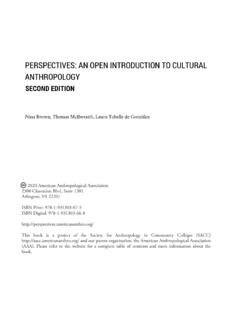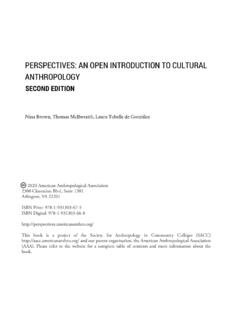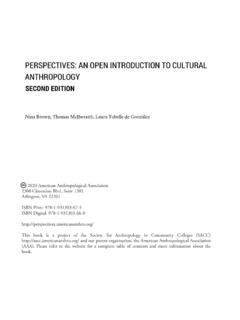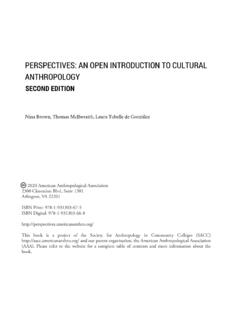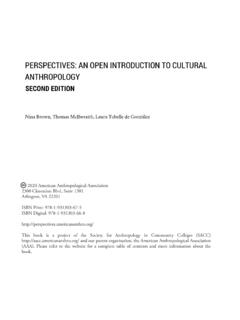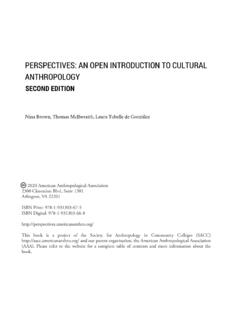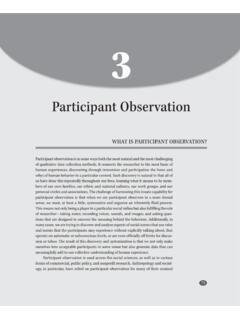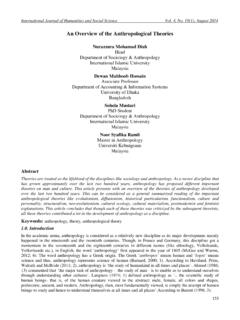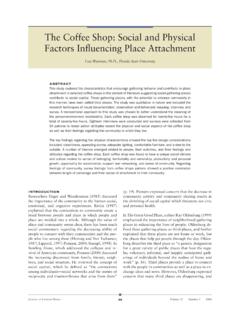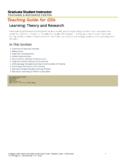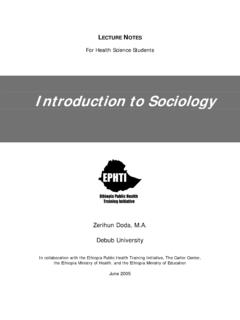Transcription of Perspectives: An Open Introduction to Cultural …
1 PERSPECTIVES: AN open Introduction TO Cultural ANTHROPOLOGY Nina Brown, Thomas McIlwraith, Laura Tubelle de Gonz lez 2020 American Anthropological Association2300 Clarendon Blvd, Suite 1301 Arlington, VA 22201 ISBN Print: 978-1-931303-67-5 ISBN Digital: 978-1-931303-66-8 book is a project of the Society for Anthropology in Community Colleges (SACC) and our parent organization, the American Anthropological Association (AAA). Please refer to the website for a complete table of contents and more information about the EDITIONP erspectives: An open Introduction to Cultural Anthropology by Nina Brown, Thomas McIlwraith, Laura Tubelle de Gonz lez is licensed under a Creative Commons Attribution-NonCommercial International License, except where otherwise noted.
2 Under this CC BY-NC copyright license you are free to: Share copy and redistribute the material in any medium or format Adapt remix, transform, and build upon the material Under the following terms: Attribution You must give appropriate credit, provide a link to the license, and indicate if changes were made. You may do so in any reasonable manner, but not in any way that suggests the licensor endorses you or your use. NonCommercial You may not use the material for commercial purposes. 3 3 DOING FIELDWORK:DOING FIELDWORK: METHODS IN METHODS IN CULTURALCULTURAL ANTHROPOLOGYANTHROPOLOGY Katie Nelson, Inver Hills Community College Learning Objectives Learning Objectives Discuss what is unique about ethnographic fieldwork and how it emerged as a key strategy in anthropology.
3 Explain how traditional approaches to ethnographic fieldwork contrast with contemporary approaches. Identify some of the contemporary ethnographic fieldwork techniques and perspectives. Discuss some of the ethical considerations in doing anthropological fieldwork. Summarize how anthropologists transform their fieldwork data into a story that communicates meaning. FINDING THE FIELD 45 Children Playing Outside a Home on the Jenipapo-Kanind Reservation, 2001 Author Katie Nelson (center) with her Brazilian Host Family, 2001 My first experience with fieldwork as a student anthropolo-gist took place in a small indigenous community in northeast-ern B razil studying the Jenipapo-Kanind of Lagoa Encantada (Enchanted Lake).
4 I had planned to conduct an independent research pr oject on land tenure among members of the indige-nous tribe and had gotten permission to spend several months with the community. M y B razilian host family arranged for a relative to drive me to the rural community on the back of his motorcycle. After several hours navigating a series of bumpy roads in blazing equatorial heat, I was r elieved to arrive at the edge of the reservation. He cut the motor and I removed m y heavy backpack from m y tir ed, sw eaty back. Upon hearing us arrive, first children and then adults slowly and shyly began to approach us. I greeted the curious onlookers and briefly explained who I w as.
5 As a group of children ran to fetch the cacique (the chief/political leader), I began to explain my research agenda to several of the men who had gathered. I men-tioned that I was interested in learning about how the tribe negotiated land use rights without any priv ate land ownership. After hearing me use the colloquial term ndio (Indian), a man who turned out to be the cacique s cousin came forward and said to me, Well, y our w ork is going to be difficult because there ar e no Indians here; w e ar e onl y B razilians. Then, abruptly, another man angrily replied to him, stating firmly that, in fact, they were Indians because the community was on an Indian reservation and the Brazilian government had recognized them as an indigenous tribe.
6 A few w omen then entered the rapid-fire discussion. I took a step back, surprised by the intensity of my first interac-tion in the community. The debate subsided once the cacique arrived, but it left a strong impression in my mind. Eventually, I discarded m y original research p lan to f ocus instead on this disagreement within the community about who they were and were not. In anthropology, this type of conflict in beliefs is known as contested identity. I soon learned that many among the Jeni-papo-Kanind did not embrace the Indian identity label. The tribe members were all monolingual Portuguese-speakers w ho long ago had lost their original language and many of their traditions.
7 Beginning in the 1980s, sev-eral local researchers had conducted studies in the community and had concluded that the community had indigenous origins. Those researchers lobbied on the community s behalf for official state and federal status as an indige-nous r eservation, and in 1997 the Funai (Fun-da o Nacional do ndio or N ational Foundation for the Indian) visited the community and agreed to officially demarcate the land as an indigenous reservation. 46 PERSPECTIVES: AN open Introduction TO Cultural ANTHROPOLOGYA young Jenipapo-Kanind boy shows off his grass skirt prior to a community dance, 2001. More than 20 years later, the community is still waiting for that demarcation.
8 Some in the community embraced indigenous status because it came with a number of benefits. The state (Cear ), using par-tial funding from Funai, built a new road to improve access to the com-munity. The government also constructed an elementary school and a common well and installed new electric lines. Despite those gains, some members of the community did not embrace indigenous status because being considered Indian had a pejorative connotation in Brazil. Many felt that the label stigmatized them by associating them with a poor and marginalized class of Brazilians. Others resisted the label because of long-standing family and inter-personal conflicts in the community.
9 Fieldwork is the most important method by which Cultural anthro-pologists gather data to answer their research questions. While inter-acting on a daily basis with a group of people, Cultural anthropologists document their observations and perceptions and adjust the focus of their research as needed. They typically spend a few months to a few years living among the people they are studying. The field can be anywhere the people are a village in highland Papua New Guinea or a super-market in downtown Minneapolis. Just as marine biologists spend time in the ocean to learn about the behavior of marine animals and geologists travel to a mountain range to observe rock formations, anthropologists go to places where people are.
10 Doing Anthropology Doing Anthropology In this short film, Stefan Helmreich, Erica James, and Heather Paxson, three members of the Massachusetts Institute of Technology s Anthropology Department, talk about their current work and the process of doing fieldwork. Making the Strange Familiar and the Familiar Strange Making the Strange Familiar and the Familiar Strange The Cultural anthropologist s goal during fieldwork is to describe a group of people to others in a way that makes strange or unusual features of the culture seem familiar and familiar traits seem extraor-dinary. The point is to help people think in new ways about aspects of their own culture by compar-ing them with other cultures.


